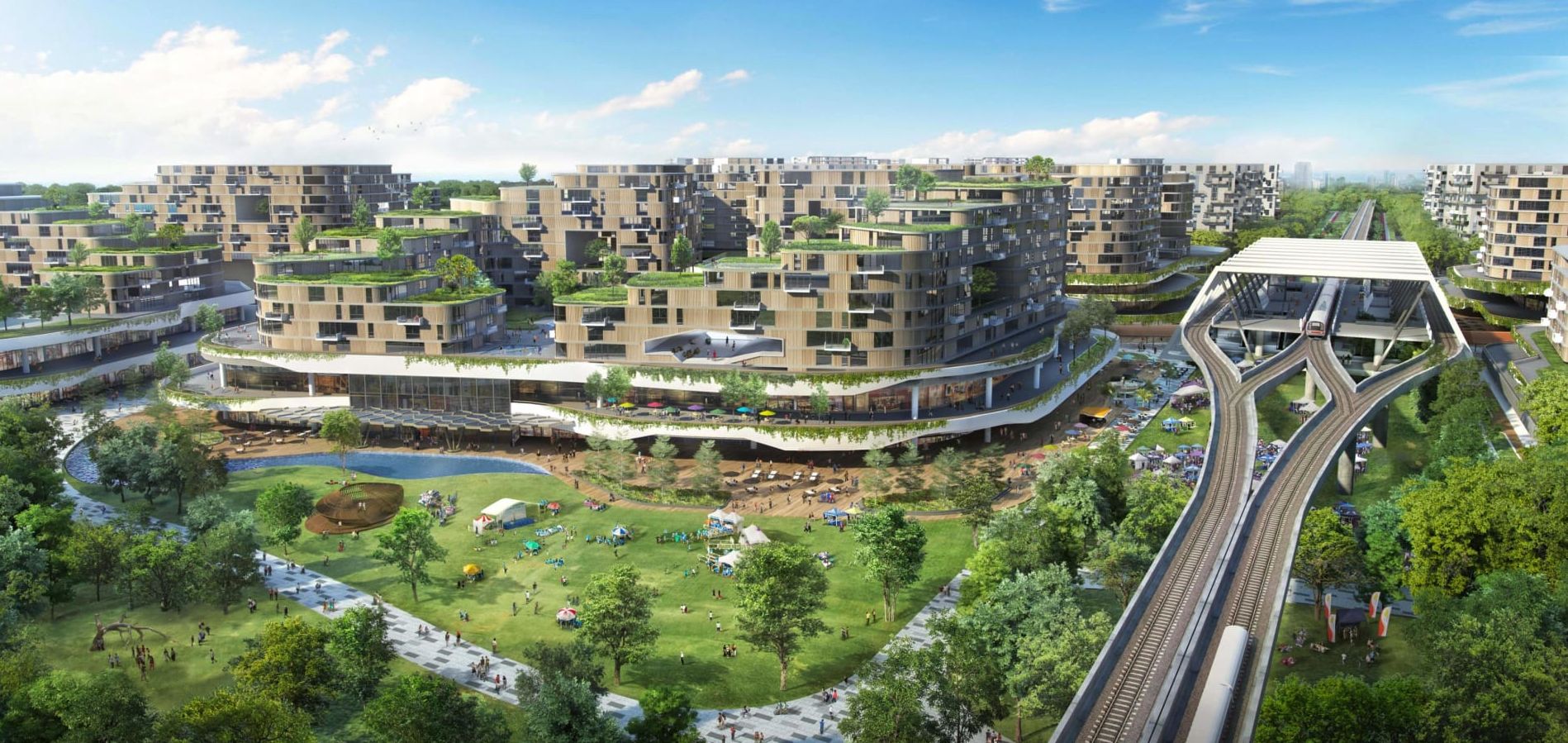The sprawling, smart eco-community of Tengah – despite a name which means ‘middle’ in Malay – will be located on the western side of Singapore.
It’s an ambitious project, to be sure, but ambition is nothing new for Singapore’s urban planners. In a tiny country where land is limited and 80% of its residents live in public housing of some sort, a high degree of planning is crucial.
Tengah, however, represents a bold new level of sustainable urban development that environmental advocates are hoping can be used as a roadmap for Singapore and other cities in Southeast Asia.

Slated to comprise 42,000 homes across five residential districts, Tengah will be the 24th new township or settlement built by the Singapore government since the end of World War II, and the first all-new town in some two decades. But setting it apart is the fact that it will be Singapore’s first with centralised cooling, automated rubbish collection, and a car-free zone in the town centre, among an array of other modern firsts.
The development is being called a “forest town” by officials, noting Tengah’s abundant greenery and landscaped public gardens. Decades ago, the area was home to brickmaking factories, and then later used for military training by the government. In more recent years, the 700-hectare site has been largely reclaimed by extensive secondary forest, something the development hopes to both preserve and capitalise on.
Accordingly, a 100-metre-wide ecological “corridor” will be maintained through its centre, providing a dedicated passage for wildlife movement, and also serving as a conduit for a water catchment area on one side to a nature preserve on the other.
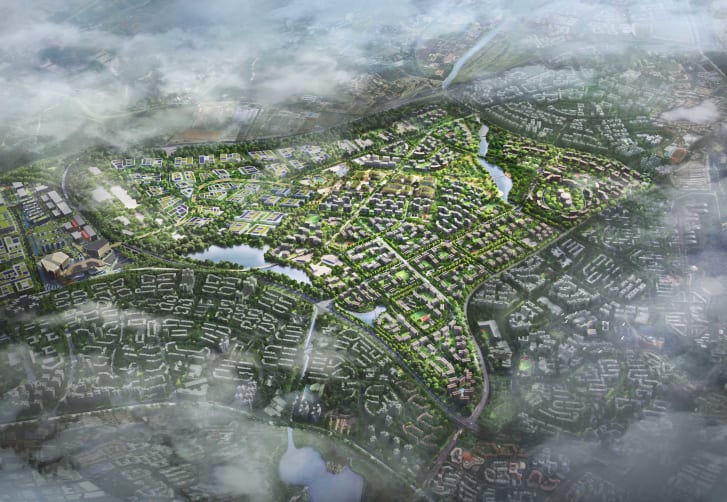
According to Chong Fook Loong, group director for research and planning at Singapore’s Housing and Development Board (HDB), the development incorporates a number of sustainable design principles and takes advantage of “smart” technology.
“Tengah is a clean slate,” he said in a video interview with CNN’s Oscar Holland, explaining that roads, parking, and utilities are all being pushed underneath the town centre. “We’re going for the ideal concept of segregation of traffic, (with) everything underground and then the ground level totally freed up for pedestrians – for people. So, it’s a very safe environment for all.
“We want a town that allows walking and cycling in a very user-friendly manner,” he added, saying that an interest in cycling has surged in Singapore in the “last three to five years, especially.”
Tengah’s master plan will also see the installation of charging stations for electric vehicles, and the streets are being designed to accommodate emerging transportation technologies, making them, to some extent, “future-proof.”
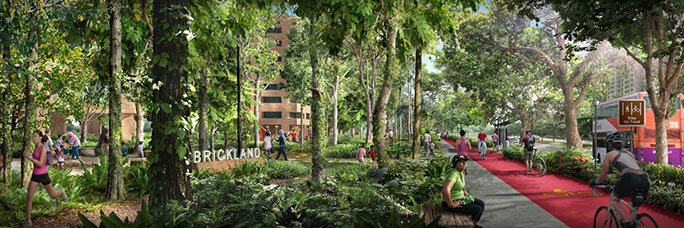
A COOLER APPROACH
Though Singapore is much smaller in land area and population than Malaysia, its per capita emissions are actually higher. (They’re also higher than those of the UK.) That’s largely down to the fact that nearly everything in the city-state is air-conditioned, which accounts for more than a third of the typical Singapore household’s energy consumption.
And it’s only going to get worse. Singapore’s Meteorological Service (MSS) has predicted that by the end of the century, average daily temperatures in Singapore will exceed 34°C nearly every day of the eight warmest months of the year.
To confront this reality, Tengah’s planners have made changes to keep things cool while reducing reliance on inefficient air-con condensers – those heat- and emissions-generating outdoor units. Instead, cold water, chilled using solar energy, will be piped through the homes located in the development.
According to the township’s energy provider, SP Group, this will generate a net carbon dioxide savings equivalent to taking 4,500 cars off the roads each year. This model for cooling homes is proving to be popular, to say the least. In fact, the state-owned energy company reports that, of the Tengah apartments already sold in advance, 9 out of 10 future residents have signed up for centralised cooling.

Tengah’s planners also used computer modelling to simulate wind flow and heat gain across the development, helping to reduce the “urban heat island” effect (whereby human activities and structures such as steel and concrete make urban areas notably warmer than the surrounding natural terrain).
Elsewhere, “smart” lights throughout Tengah will switch off when public spaces are unoccupied, and rubbish will be stored centrally, with monitors installed to detect and alert when garbage needs collecting.
“Instead of using a truck to collect garbage from every block, we will suck all the garbage through the pneumatic system to a chamber that serves several blocks,” Chong explained. “From time to time, the (garbage) truck just needs to collect from the chamber.”
It’s all part of an interconnected design ethos, Chong said as he talked about how the choices behind Tengah’s planning will in turn inform future developments.
“We try to bring all the lessons forward, whenever we can and to the best of our ability,” he said. “You look at Tengah and, in a nutshell, you’re seeing the future of what the (government) is trying to build: the future of towns.”
A NATURAL CONNECTION… BUT NOT WITHOUT CRITICS
For sustainability advocates, Tengah’s integration of nature with residential areas is what sets the development apart. In addition to the corridor mentioned earlier, residents will have community farming options, too, as part of the township’s Plantation District.
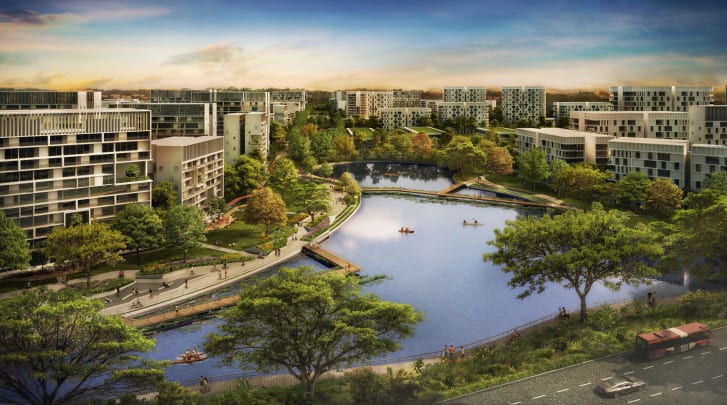
Perrine Hamel, an assistant professor at Nanyang Technological University’s Asian School of the Environment, says that Tengah will create “more opportunities for people to interact with nature” and that the focus on preservation and conservation in the town can actually engender positive behavioural changes in its residents.
“There are a lot of examples – from around the world – showing that changing our relationship with nature through everyday encounters does help people take environmental action,” she said. “On that front, I think the biophilic design and (Tengah’s) master plan actually does a good job.”
But that’s not to say the plan is totally free from criticism.
The Nature Society Singapore (NSS) has come forward with comments saying that plan actually conserves too little – less than 10% – of the site’s existing secondary forest. The environmental advocacy group has proposed two additional “core forest areas” at either end of the green corridor, which they say will promote biodiversity and protect migratory species. The government is reportedly considering implementing some changes that would increase the footprint of preserved forest areas.
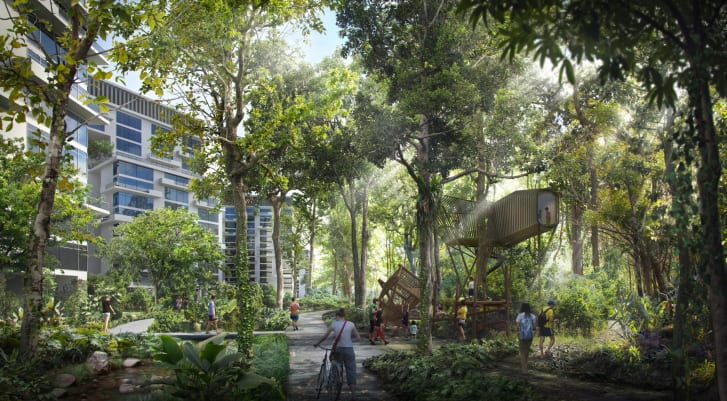
SMARTER BY DESIGN
Of the 42,000 homes being built at Tengah, more than 70% will be made available through Singapore’s HDB long-term leasing scheme. Prices for two-bedroom apartments currently begin at just S$108,000 – probably quite the bargain in pricey Singapore – with the first residential units set to be completed in 2023.
Another new feature is a dedicated Tengah app, available to all residents, which will allow them to monitor their energy and water usage. (“You empower them to take control of where they can cut down their energy consumption,” Chong said.) Digital displays located in each of the township’s block, meanwhile, will inform residents of their collective environmental impact, which could even encourage a friendly sort of “eco-competition” between residential blocks, according to a statement from SP Group.
Hamel chimed in again here, saying that whether or not these technologies make a dent in carbon emissions on their own, she things engaging with residents like this about their own energy consumption habits is a great move, and says it may play a significant role in Singapore’s stated goals of reaching peak emissions by 2030 and reducing them thereafter.
“Thinking about food consumption and thinking about the way people use air conditioning is all part of (achieving climate targets),” Hamel said. “Changing behaviour is going to be an integral part of it and, of course, urban design is the first way to affect and change behaviour.”
All images above are artist’s impressions only. To find out more, visit the Singapore HDB Tengah website.

"ExpatGo welcomes and encourages comments, input, and divergent opinions. However, we kindly request that you use suitable language in your comments, and refrain from any sort of personal attack, hate speech, or disparaging rhetoric. Comments not in line with this are subject to removal from the site. "


